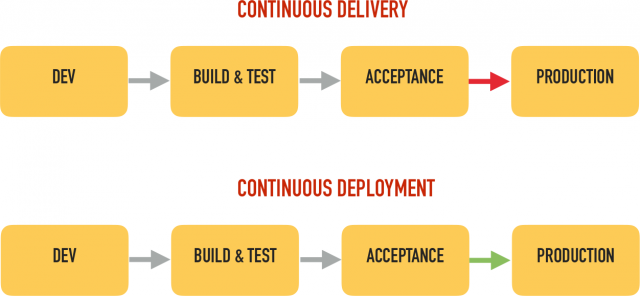I’m writing this post to contribute my take on the acronym CD, and the distinction (or perhaps, confusion) between the phrases Continuous Delivery and Continuous Deployment. These phrases are used interchangeably, and sometimes incorrectly, in various books, blogs and talks. And while these software engineering approaches (or disciplines) share a lot, there is one key difference.
Continuous Everything
Let’s first discuss two important cornerstones of CD: Continuous Integration (CI) and automation.
Continuous Integration has been around for a while. A phrase that was first coined in the nineties, it was further refined and explained by Beck and Fowler. CI refers to the practice of integrating changes to a code base regularly, preferably multiple times per day. Each integration is verified by running some sort of build, which should be self-testing, automated, fast and repeatable. This enables quick detection of errors and conflicting changes, resulting in a more stable (and faster) development process.
Continuous Delivery expands on CI and adds a process to automatically deploy a build to an acceptance environment. There, the team can access and manually test the product. When the build is considered ready for general consumption, a developer can promote it to the production environment by a simple button click.
Now, one of the goals of CD (regardless of what the D means) is to achieve shorter development cycles, i.e. reduce the time for new features or product ideas to be put in production and validated. Having a manual gate somewhere in the release process means that the cycle time won’t be as short as it could be, if everything were automated. Enter Continuous Deployment: automating every single step of the way, no manual promotions. To me, this is true CD. Luckily, Wikipedia agrees with me.

In future blog posts I’ll discuss some of the requirements to effectively implement Continuous Deployment, and how to easily set up a proper pipeline in minutes, as code, with Jenkins 2. We’ve come a long way since CruiseControl…
Final thoughts
I’ve been thinking about the phrase “acceptance environment”. In true CD, there are no acceptance tests, at least not of the traditional, manual kind. So, with nothing to “accept”, the phrase seems to have lost some of it’s value. From an automated test point of view however, the environment itself is still useful. Ideally equivalent to production, where we can run performance and load tests, and verify deployments before progressing to the production stage.
Pre-production? Functionally Equivalent To Production (FETP) ? Let me know if you can think of something better!
Pingback: The hierarchy of Continuous Deployment - Touchdown Consulting Services
Pingback: CD: Continuous Delivery or Continuous Deployment? | make.io
Pingback: A typical CI/CD pipeline explained - Michiel Rook's blog